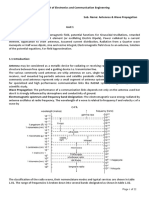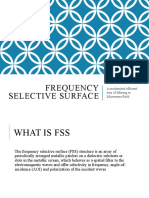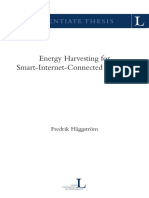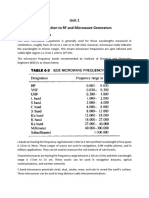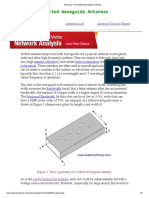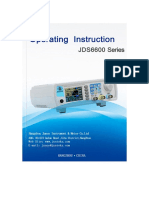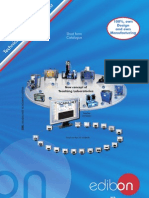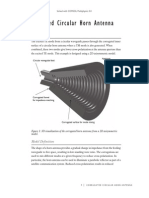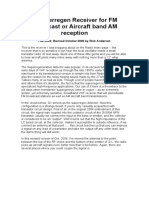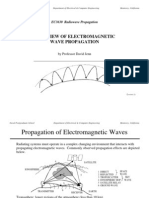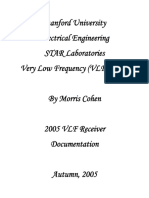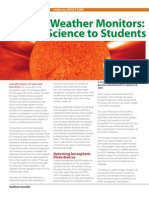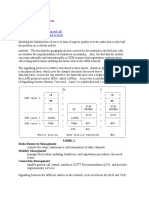3URFHHGLQJ�RI�WKH������,QWHUQDWLRQDO�&RQIHUHQFH�RQ�6SDFH�6FLHQFH�DQG�&RPPXQLFDWLRQ��,FRQ6SDFH���������$XJXVW�������/DQJNDZL��0DOD\VLD
Development of Very Low Frequency (VLF) Data
Acquisition System Using Raspberry Pi
Y.L. Soon1, K.B. Gan1, 2 & M. Abdullah1,2
Department of Electrical, Electronic & Systems Engineering, UKM, Bangi, Malaysia
2
Space Science Center, Institute of Climate Change, UKM, Bangi, Malaysia
gankokbeng@ukm.edu.my
AbstractSpace
weather is an important area of
research. The Space Weather Monitor program was
introduced by Stanford SOLAR Center with the aim of
building and distributing inexpensive ionospheric
monitors (SID). These are used to detect changes to the
Earths ionosphere which are caused by solar flares and
other ionospheric disturbances that might affect very
low frequency (VLF) radio propagation. SuperSID that
has been developed by Stanford SOLAR Center for SID
detection is a low cost but sensitive space weather
monitor which is currently being used around the world.
Since 2010, UKM has participated in the International
Space Weather Initiative (ISWI) and this program has
given positive impact and triggered Malaysian students
interest in space science at the secondary school level. In
2012, researchers at University Kebangsaan Malaysia
(UKM) succeeded in building their own VLF receiver
system, known as the UKM-SuperSID for SID detection,
effectiveness determination and development of a
teaching kit for SuperSID Introductory Project.
However, for both systems, a desktop PC is needed in the
existing system to run the SID program and to save the
data for further analysis. Thus, power consumption, cost
and size of the computer are becoming limiting factors
for educators in Malaysia who wish to attract the
interest of the young students in Science, Technology,
Engineering & Mathematics (STEM) education. This is
mainly because the UKM-SID system currently
comprises of a loop antenna, preamplifier, sound card
and a computer where the computer is required to
capture, analyze and save the data, making it difficult to
bring it to schools and the community. To overcome this
problem, a portable VLF data acquisition system using
Raspberry Pi was proposed to detect SID in this study.
This system consists of a VLF receiver, preamplifier,
analog to digital converter (ADC) and Raspberry Pi. The
acquisition software was compiled with Python and run
in the Linux environment. As a result, a portable VLF
acquisition system using Raspberry Pi has been
successfully developed which is able to detect and
monitor frequencies transmitted from FTA (16.8 kHz),
France and NWC (19.8 kHz), Australia.
I.
Free electron in the ionosphere reflects very low
frequency (VLF) radio signal to allow radio communication
over the horizon and around our curved Earth. The strength
of the received radio signal changes according to how much
ionization has occurred at the ionosphere where the VLF
waves reflect from [1]. Hence, field strength monitoring of
VLF radio wave transmission via the ionosphere of the
Earth is an important ground base to study solar flares and
their effects on VLF wave propagation within the range of
3-30 kHz. At VLF, both ground and ionosphere are good
electrical conductors and forms a spherical earth-ionosphere
waveguide [2]. The unique VLF propagation is used over
the globe for stationary naval vessel to communicate with
the divers as the wave can penetrate into the oceans.
Besides, scientists have used the frequencies of VLF to
study the natural phenomena that occur on land and in space
[3,4].
Sudden Ionospheric Disturbance (SID) occurs in
association with the ionospheric electron density variations
and has long-lasting effects on the ionosphere [3]. Each
layer of the ionosphere has a characteristic critical frequency
that relates to the number of electrons in the layer. The
electron density in the ionospheric layers varies mainly with
the X-ray radiation created during the solar flares. During
the high solar activity periods, large amount of X-ray and
EUV flux strikes the D-region heights of the ionosphere
(from 50 km to 90 km) and increase the ionization rate
hence electron density [4]. These occurred of disturbances
have an influence on the propagation of VLF radio wave.
Stanford SOLAR Center has introduced a Space Weather
Monitor program with an aim to build and distribute an
inexpensive ionospheric monitors (SID) that used to detect
changes to the Earths ionospheric caused by solar flares and
other ionospheric disturbances [5]. Currently, most people
around the world are using the low cost but sensitive space
weather monitor, named as SuperSID that has been
developed by the Stanford SOLAR Center for SID detection
[5]. In 2012, researchers University Kebangsaan Malaysia
(UKM) had succeeded to build out their own VLF receiver
system, known as UKM-SuperSID for SID detection,
effectiveness determination and development of teaching kit
for SuperSID Introductory Project [6,7]. For both systems, a
desktop PC is needed to run the SID program and save the
Keywords-SuperSID, VLF acquisition system, Raspberry Pi,
Python, ionosphere
T
���������������������������������,(((
INTRODUCTION
���
�data for further analysis. As such, it is difficcult to bring it to
the school and the community to promote space
s
science to
our school children due to its size, coost and power
consumption. In order to increase our youung generations
interest in Science, Technology, Engineering
E
&
Mathematics (STEM), an easier way to setup
s
a portable
space weather monitoring system is developed and
promoted to them.
A. Loop Antenna
The loop antenna as shown in Figure 2 (built by
PERMATA PINTAR studennts, UKM) was used to capture
the VLF signal from variouus VLF transmitter stations. The
antenna was made up of low
w cost PVC frame and 20 turns of
#26 AWG wire, with the size of 1 meter square. RG58
coaxial cable was used to coonnect the antenna output to the
UKM-SuperSID preamplifieer.
Thus, the purpose of this project is to devvelop a portable
VLF data acquisition system using Raspberrry Pi. Raspberry
Pi with small form factor is used to replacce the huge size
desktop PC. The system consists of VLF receiver,
preamplifier, ADC, Raspberry Pi and LCD display.
Peripheral devices can be accessed through the
t Raspberry Pi
with the Python. SuperSID is an open sourcee software which
written in Python. It is available from the GiitHub website to
acquire data from connected devices annd display the
collected data. Several steps in setting the configuration file
of SuperSID have been carried out, so that the
t software can
run properly [8].
II.
METHODOLOGY
The project divided into two main partss, hardware and
software development. The hardware part consists of an
R
Pi and
antenna, preamplifier, a USB sound card, Raspberry
LCD display. For software part, the SupperSID software
written in the Python has downloaded in Raspberry
R
Pi to
capture the signal from the desire stationn. The Supersid
software is open source and available downnloaded from the
website https://github.com/ericgibert/superssid [9]. Fig. 1
shows the block diagram of the VLF data acqquisition system
which consists of a power supply, loop antenna,
preamplifier, ADC, Raspberry Pi and LCD display. The
a
and very
distant VLF signal is received by the loop antenna
low induced output voltage is amplified by the
t preamplifier.
A 9V adapter was used to supply the power to the
preamplifier. The amplified VLF signal was sampled at 44.1
kHz using a USB external sound card (Creative Sound
Blaster X-Fi Go! Pro). Thus, the data acquiisition system is
able to detect signals with maximum frequenncy up to half of
the sampling rate, 22.05 kHz. The received VLF signal was
processed and stored in Raspberry Pi using the SuperSID
software.
Figure 2. Loop Antenna
B. UKM- SuperSIDPi Pream
mplifier
The UKM-SuperSIDPi preamplifier
p
was built based on
the SuperSID preamplifierr developed by the Stanford
SOLAR Center [6]. The UK
KM-SuperSIDPi preamplifier is
redesigned into a small doouble layer PCB (32.55x47.01
mm2 ) and which is able too connect to the USB external
sound card and Raspberry Pi
P easily [5]. In this work, the
surface mount devices (SMD) components were chosen to
d to small form factor of the
solder on the preamplifier due
preamplifier. The schematiic diagram (Fig. 3) and PCB
layout (Fig. 4) of the pream
mplifier were redrawn using the
electronic CAD software.
Figure 1. Block diagram of VLF monitorinng system
Figure 3. Schematic diagram
m of UKM-SuperSIDPi preamplier
486
�The USB sound card was added in the configuration file
using command Card = Proo.
III.
RESULTT AND DISCUSSION
A. UKM-SuperSIDPi Pream
mplifier PCB Board
The newly designed PCB
B board has a smaller form factor
(32.5547.01 mm) comparred to the existing ones from
Stanford SOLAR Center ass shown in Fig. 5. The original
SuperSID preamplifier hass gain around 1000 [5]. The
performance of the UKM-SuperSIDPi preamplifier was
carried out using a functionn generator with the frequencies
swept from 2-200 kHz wiith amplitude of 20 mV. The
amplifier gain can be determ
mined using Eq. 2.
Figure 4. PCB layout of UKM-SuperSIDPi preamplier
p
C. USB Sound Card Configuration
The sound card is needed to convert the signal from
analog to digital. Creative Sound Blaster X-F
Fi Go! Pro sound
card was used to capture and sample the amplified
a
signal
from the preamplifier. The USB sound carrd is capable to
sample the amplified signal at the samplingg rate of 44100
kHz. The sound card setting was done in thee LXTerminal in
order to make sure that the USB sound card was detected by
Raspberry Pi [10, 11].
��
(2)
where preamplifier ouutput voltage.
D. Raspberry Pi and Display
Raspberry Pi is a credit-card sized compputer that can be
used in electronics projects and works as the desktop PC, for
example playing high-definition video [8]. The Raspbian
Wheezy operating system was installed intoo the Raspberry
Pi using a 32 GB Class 10 SD card. Claass 10 SD card
supports 10 MB/s non-fragmented sequenttial write speed
which enables the high speed bus mode. A LCD monitor
was used as the display for Raspberry Pi thrrough the HDMI
interface.
E. SuperSID Software on Raspberry Pi
SuperSID software is an open source software available
from GitHub (https://github.com/ericgibert/supersid). Since
the SuperSID software was written in Pythoon software and
maintained by Eric Gibert [9]. There are extrra modules need
to be installed on Raspberry Pi in order to ruun the SuperSID
software. These modules are matplottlib, wxPython
(wxgtk2.8), numpy and alsaaudio. Matplotlib was used to
plot the SID data and Advanced Linux Souund Architecture
(alsaaudio) has full support for capturing annd playing back
the audio signal. Numpy is a general--purpose arrayprocessing package to manipulate large muulti-dimensional
arrays of arbitrary records. The wxPython is
i a GUI toolkit
that allows users to create programs with highly
h
functional
graphical user interface.
Before execute the Supersid software, thhe configuration
files (supersid.cfg) needs to be properlyy configured to
monitor VLF signals from the desire stattion. Command
viewer=wx is used to enable the graphicaal user interface
(GUI) mode. The GUI mode requires moree resources from
Raspberry PI compared to the text mode thatt can be enabled
via command viewer = text. The command line
a supersid.cfg
audio_sampling_rate in the sampler.py and
files has to be changed to 48000 Hz deppending on the
sampling rate supported by the sound cardd. The acquired
data will be saved in the pre-configured dataa_path directory.
Figure 5. UKM-S
SuperSIDPi PCB Board
The gain versus frequenccy plot is shown in Fig. 6. Based
on Fig. 6, the UKM-SuperS
SIDPi preamplifier has low pass
filter characteristic with a cutoff frequency at around 25
kHz.
Figure 6. Graph of Gain versus Frequency for the UKM-SuperSIDPi
preaamplifier
B. VLF Acquisition System Test
T
The VLF data acquisitioon system consists of Raspberry
Pi, UKM-SuperSIDPi preaamplifier, USB sound card is
shown in Fig. 7. It was installed
i
in Level 6, Research
Complex, UKM to monitoor VLF signals from various
stations.
487
�IV.
CONCLUSION
A portable VLF data acquisition system using Raspberry
Pi has been developed in this project. The VLF monitoring
system has successfully detected the frequencies transmitted
by NWC (19.8 kHz) from Australia. This tool could be a
very useful teaching aid for promoting science, technology,
mathematics & space science education to the students in
secondary school. The educators can easily operate the
system without the need of expensive computer. Besides
that the developed acquisition system can be implemented
for diurnal variation, sudden ionosphere disturbance and
solar flare detection. For future work, 96 kHz USB sound
card namely, Wolfson audio card is suggested to be
implemented to capture signals from the VLF transmitter
station that has frequency more than 22 kHz.
Raspberry
Pi
USB Sound
Card
Preamplifier
Figure 7. The overall system setup
The system was connected with loop antenna and the data
was logged hourly into the SD card for further analysis. The
system was configured earlier to monitor VLF at 19.8 kHz
transmitted by the transmitter station at NWC, Australia [5].
A distinct peak 19.8 kHz has been detected by the VLF
acquisition system (Fig. 8).
ACKNOWLEDGEMENT
The authors would like to thank the Yayasan Sime Darby
(YSD) for sponsoring this work under the Kursi Perubahan
Iklim UKM-YSD Grant: ZF-2014-019.
REFERENCES
Murray, S. 2006. Tracing Particles from the Sun to the Earths
Ionosphere, http://solar-center.stanford.edu/SID/StudentWork/ [5
Disember 2006].
[2] More, C.T., Sharma, A.K., Bhonsle, R.V. & Kenneth J.W. Lynn,
Field Strength Measurement of VLF Radio Wave Propagation at
19.8 kHz between Australia and India, Proceedings of the 10th
Australian Space Science Conference, pp. 249 262, 2010.
[3] Suryadi, Abdullah, M. & Husain, H., Development of VLF receiver
for remote sensing of low atmospheric activities, Proceeding of the
2009 International Conference on Space Science and Communication,
pp. 230 234, 2009.
[4] Moral, A.C., Eyiguler, E.C.K. & Kaymaz, Z., Sudden ionospheric
disturbances and their detection over Istanbul, Recent Advances in
Space Technologies (RAST), 2013 6th International Conference, pp.
765 768, 2013.
[5] Scherrer, D., Mitchell, R., Huynh, T., Lord, W. & Lord, M., SuperSID
Users Manual, Stanford Solar Center, 2010.
[6] Wong, P.W., Abdullah, M. & Hasbi, A.M., Development of A VLF
Receiver System for Sudden Ionospheric Disturbances (SID)
Detection,
IEEE
Asia-Pacific
Conference
on
Applied
Electromagnetics (APACE 2012), pp. 98 103, 2012.
[7] Abdullah, M., Bais, B., Hasbi, A.M., Majid, R.A., Yatim, B., Ali,
M.A.M., Bahari, S.A., Daud, N.M., Mokhtar, M.H., Zain, A.F.M., &
Asillam, M.F., Development of UKM-SID teaching module for
space science education, International Forum on Engineering
Education 2012 (IFEE 2012), pp. 80-85, 2012.
[8] Michalak, S., Raspberry Pi as a measurement system control unit,
Signals and Electronic Systems (ICSES), 2014 International
Conference, pp. 1 4, 2014
[9] Gibert, E., SuperSID, https://github.com/ericgibert/supersid, 2013 [25
Ogos 2013].
[10] Merrick, J., Using a USB Audio Device with a Raspberry Pi,
http://computers.tutsplus.com/articles/using-a-usb-audio-device-witha-raspberry-pi--mac-55876, 2013 [1 November 2013].
[11] Bryan, L.X.Z., Teo, J.H. & Meredith, T.S., Development of a
System for Atmospheric Observations in School of Science and
Technology, Singapore, http://sst2013-s207iss-f.blogspot.com/p/2methods.html, 2014 [1 Jun 2014].
Power Spectral Density (dB/Hz)
[1]
Frequency
Figure 8. Clear peak 19.8 kHz detected by the VLF monitoring system
C. Comparison between UKM-SuperSID and UKMSuperSIDPi
Table 1 shows the comparison between UKM-SuperSID and
UKM-SuperSIDPi system. The UKM-SuperSIDPi system
has lesser power consumption (10W) and cheaper (RM 120)
compared to the UKM-SuperSID. It does not require any
desktop which enables it for educational purpose without
extra investment in the computer system.
TABLE 1 Comparison between UKM-SuperSID and UKM-SuperSIDPi
UKM-SuperSID
Dekstop / Laptop PC
Windows OS
500 Watt
RM 1 500.00
Any Soundcard
(Maximum sampling rate:
96 kHz)
UKM-SuperSIDPi
Raspberry Pi model B
Linux OS
10 Watt
(2 A @ 5 V)
RM 120.00
USB External Soundcard
(Maximum sampling rate:
48 kHz)
488






